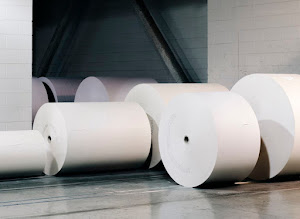 |
| Newsprint rolls (Photo by David Kasnic, The Washington Post) |
Associate Professor of Journalism, University of Kentucky
A shortage of truckers and blockade bottlenecks have put a crimp on newsprint deliveries to the nation’s newspapers.
Those delays, combined with fears of a newsprint shortage, have raised publishers’ anxiety and put a premium on delivery schedule planning.
“Yes, the newsprint situation is severe,” said K. Brett Wesner, chair of the National Newspaper Association, a not-for-profit trade association representing the owners, publishers and editors of community newspapers in the U.S.
Wesner is a member of the family publishing group Wesner Publications Co., based in Cordell, Oklahoma, which publishes 15 titles in Oklahoma, Texas and New Mexico.
The crunch appears to come from a backlog caused by the blockade by Canadian truckers to protest pandemic restrictions, said Kentucky Press Association Executive Director David Thompson, the longest-tenured newspaper-association executive in North America.
“Apparently the Canadian blockade is to blame because all or most all is coming from Canada,” Thompson said, referring to the main source of supply for the U.S.
Thompson said one KPA member told him “The Canadian truck convoy was part of the problem for a while, but there is just a shortage of truckers right now. We’re told the newsprint has been produced but is waiting in storage for a driver to pick it up.”
 |
| David Thompson and Jay Nolan (2019 photo by Al Cross) |
Nolan, the 2019 KPA president, said his firm ordered all standard newsprint 12 months in advance from PAGE Cooperative, the largest purchasing co-op in the U.S. for newspapers and commercial printing.
Canada, the No. 1 newsprint paper supplier to the U.S., itself has not been spared. An article published last month in the Toronto Star with the headline “Paper shortage impacting local newspapers” included a line that late last year “an issue of the Toronto Sun didn’t get printed because there simply wasn’t enough newsprint.”
“There are too few trucks and truck drivers in the market, so deliveries to newspaper printers are often delayed or unpredictable,” said Smithson, a regional director of printing operations for Adams Publishing Group, a major community newspaper company.
This week, Smithson said, “One supplier recently told us that they had lined up only 76 trucks and drivers for the 872 loads they had planned to ship. That illustrates the scope of the challenge.”
In Kentucky the situation is best described as more of “a crunch” than “a severe
newsprint shortage,” Thompson said.
At another operation involving three printing plants, Thompson said, “They are working on a low number of days, well, lower than they like to make it comfortable, but it’s the same thing: Shipments. I don’t know what it requires to be a ‘severe newsprint shortage.’ One described it as a crunch.”
Smart planning and patience has averted trouble in Kentucky, even though there have been close calls.
“We heard of the newsprint shortage in June of 2021,” said Ricky Reed, lead pressman for The Winchester Sun, where the Boone Newspapers in Kentucky print, “and were asked by our publisher to put in newsprint orders up until June of 2022.”
Although the newspaper has experienced delays for a week or two of the newsprint it receives from a mill in Canada, Reed said, “We have never missed a shipment due to a shortage.”
That view was echoed by Mike Scogin, president and publisher of the nearby Georgetown News-Graphic, which has a press.
“The problem is more with trucking than a newsprint shortage … just a challenge with shipping,” Scogin said. “We have been delayed a few days, but nothing unmanageable. It just takes a little more planning.”
Nolan, president of Mountain Advocate Media, based in Barbourville, turned a family business of two weekly newspapers into Nolan Group Media, which now consists of eight weeklies, two commercial printing plants, a commercial sign company and an office machine company.
Nolan said small, rural papers are more threatened by the shortage because most of their printers are independently owned "or have newsprint agreements with only one or two mills," not the cooperative. "Some have limited storage capacity. As the paper market gets tighter, trucking delays make just-in-time delivery more problematic."
Nolan listed several contributing factors for the shortage, including:
- A decline in demand for newsprint caused mills to close or convert their machines to other types of paper. The pandemic further crushed demand as newspapers closed, “six in Kentucky I know of.” Those were owned by Community Newspaper Holdings Inc.
- With fewer mills making newsprint, producers are running near capacity.
- As the pandemic rose, Covid-19 diminished the ability of providers to fully staff remaining producing plants: “Classic supply/demand/production bottleneck.”
- Increased regulations have dramatically raised requirements and training for someone to get a Class A commercial driver's license, causing a national shortage of truck drivers. Gasoline price increases have hurt the trucking industry even further.
- Delays in getting produced paper picked up for shipment has filled mill warehouses and shipping docks to a saturation point.
Nolan is not optimistic the situation will improve soon. “Recently, I was told lack of storage capacity is now hampering production,” he said. “Also, mills are running at such high capacity level, maintenance is curtailed. Now, any breakdown of machinery pushed too hard stops production.”
No comments:
Post a Comment